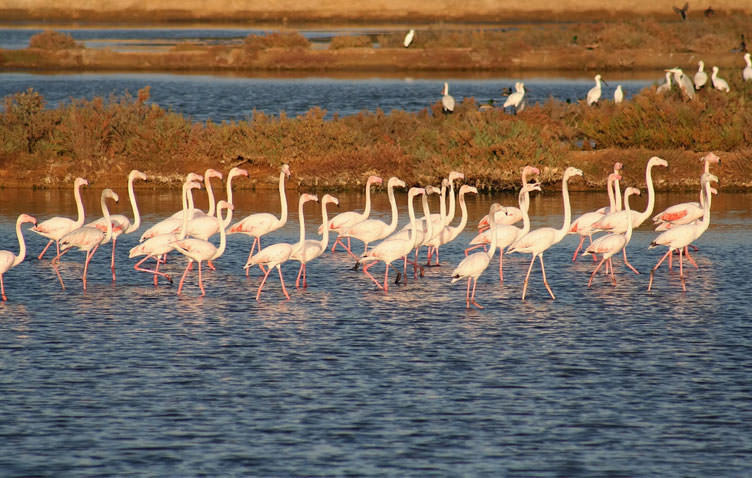It is also integrated in the Rede Natura 2000 as a special protection area, established by the Directive BIRDS (who classified Ria as a wetland with Community importance as an habitat for birds), and as a special area of conservation, by the Habitats Directive (which recognized Ria as a natural habitat for wild flora and fauna with community importance).
It has about 18,400 hectares, and 60km of extension between Ancão area and Manta Rota area. It partially covers the municipalities of Loulé, Faro, Olhão, Tavira and Vila Real de St. António. Contains beaches, five barrier islands (Deserta or Barreta, Culatra, Armona, Tavira and Cabanas) and two peninsulas (Ancão and Cacela), islets, and largely marshland areas and lagoon areas, covered by a dense network of water channels with an average depth of 2m.
Geologically, the area is mostly composed by sands, sandstones and limestones.
Most of watercourses that flows into the estuary are seasonal, this fact and the low rainfall leads to a lagoon system receiving mostly salt water from the ocean.
Ria Formosa has several habitats: barrier islands, salt marshes, sand banks and mud, dunes, salt marshes, freshwater ponds, brackish water lagoons, rivers, forests and agricultural areas, which allowed a huge diversity of flora and fauna.
Regarding flora ria has dune vegetation (marram, cottonweed), salt marsh vegetation (small cordgrass), the forest (maritime pine, stone pine, sobreiro, Olea europea var. sylvestris, lavander and thyme) and riverside vegetation (common reed, thypha).
Regarding fauna Ria is a privileged area for shelter and feeding, reproduction and persistence of numerous animal species. The composition and abundance of zooplankton in the estuary is a very important factor.
Ria have mammals (otter, genet, beech marten), reptiles (moorish gecko, chameleon), amphibians (perez’s frog, frog), birds (spoonbill, grey heron, gannet, oystercatchers, sandwich tern, loon-necked black oystercatchers, bar-tailed godwit, black-headed gull), insects (dragonfly), cephalopods (octopus, cuttlefish, squid), crustaceans (green crab, uca tangeri), bivalve molluscs (chequered carpet shell, oysters, common cockle, cockles, razor clam), annelids (sand worm), and fish (two banded sea bream, sea bream, goldline, sea bass, pagrus, pandora, eel; and the Ria has the largest community of seahorses in the world: long snout seahorse, and short snout seahorse).
Ria’s environmental and landscape characteristics gives it a high scientific, cultural social and economic value which has been preserved over time.
There are over 200 thousand people in total area of the counties partially included in the Park of Ria Formosa, which is a high density of population. Including residents of the villages of the barrier-islands (Armona, Culatra, Hangares, Farol, and Faro Island), which was started with the migration of fishermen families of the coastal towns.
The presence of men is noticed all over the Ria, in urban centers, isolated buildings and tourist villages. But there has been a growing effort to not change the balance of this rich ecosystem.







0 comments:
Post a Comment